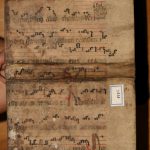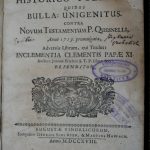The musical notation of the antiphonal fragment at the Zagreb Archdiocesan Theological Seminary shows prominent similarity to those leaves which cover the host volumes A-V-179 and A-V-180 in the Franciscan library in Zagreb (see F 1105, F 1106). Also, the strip strengthening the spine of the Zagreb City Library’s volume R-454 (F 1113) assumedly originates from the same source. According to its content, F 1118 belongs to the temporale, two responsories sang with the November lessons from the prophets and a part of the invitatory are preserved on it, thus it represent the same Office whose responsories are preserved on F 1113. The correspondence is certainly not incidental: the codicological and musicological examination proved that both fragments (F 1113 and F 1118) come from the same antiphonal, the leaves supposedly subsequent to each other in the mother codex. The design of the sanctorale parts differs on a few instances: the use of the custos is consistent there, while it can only be shown at the end of the third line in F 1118. The staves and the neume heads are smaller. The drawing of the climacus is also dissimilar: on the temporale fragments they are somewhat unarrayed; the notation of the sanctorale is written with more care and flexibility.
On the title-page of the host volume a possessor’s inscription is transmitted, indicating the book belonged to István Vuchetich (1836–1894), the famous doctor of canonical law, canon of Zagreb and provost of Csázma / Čazma. The circumstances of the binding process have since fallen into oblivion, however, based on Zagrabian analogies it can be rightly assumed that it happened at a local bookbinding workshop, and as we have formerly seen, a local, Zagreb antiphonal was used up for the binding. The characteristics of the musical notation were broadly presented in the description of F 1105, the liturgical-musical content gave material for examination in the case of the more recent fragments. The Zagreb origin was ascertained by the chant order and chant selection at the investigation of the other two leaves. Fortunately, the fragment in question also preserved a significant part of the Office, albeit the provenance-markers reveal themselves slightly less than in the parts carrying the Offices of Saints.
Some of the invitatories standing at the beginning of the summer responsory-series differ significantly between the liturgical subtraditions of Hungary. The invitatory Laudabilem virum typical to the Central-European region occurs at the beginning of the responsories of the Historia Prophetarum in most of the central Esztergom and Transylvanian-Várad sources (cf. László Dobszay ed., Corpus Antiphonalium Officii Ecclesiarum Centralis Europae V/A Esztergom / Strigonium (Temporale), Budapest, HAS Institute for Musicology, 2004, 228, 276; Andrea Kovács ed., Corpus Antiphonalium Officii Ecclesiarum Centralis Europae VII/A Transylvania-Várad (Temporale), Budapest, HAS Institute for Musicology – Ferenc Liszt Music Academy, Church Music Research Group, 2010, 216). Contrary to this, the Zagreb codices mostly put the invitatory Regem Christum adoremus at the beginning of the series (cf. Andrea Kovács ed., Corpus Antiphonalium Officii Ecclesiarum Centralis Europae CAO-ECE VI/A Kalocsa-Zagreb (Temporale), Budapest, HAS Institute for Musicology, 2008, 120). The fragment in question uses the latter solution. For this unique invitatory choice and the exception of Zagreb see Gabriella Gilányi, „Laudabilem virum, Adaperiat Dominus cor. Egy virtuális invitatórium-széria az őszi zsolozsmákban [A virtual invitatiory series in the Autumn Offices]”, in Márta Sz. Farkas (ed.), Zenetudományi Dolgozatok 2006–2007, Budapest: HAS Institute for Musicology, 27–40; Gabriella Gilányi, „Liturgical and Musical Properization of Mode 2 Invitatories in the Autumn Matins”. De musica disserenda IX (2014/1–2), 123–137. The last notes of an antiphon and the connecting 1st mode differentia is legible on the top of the leaf. The –ael syllable of the antiphon text’s end and the mode refer to the antiphon Sustinuimus pacem ending with Deus Israel, which occurs at the end of the series of Magnificat-antiphons in most Zagreb sources, cf. Andrea Kovács ed., Corpus Antiphonalium Officii Ecclesiarum Centralis Europae VI/A Kalocsa-Zagreb (Temporale), 121, 156.
Gabriella Gilányi



